The men and their duties
| < The Port Laing Minefield | Δ Index | Port Laing Beach today > |
The men were assigned duties in a number of specialized parties.
Priming Party – making a final inspection of apparatus, inserting dry primer, and issuing primed apparatus to the mine store.
Mine Store Party – inserting primed apparatus, putting mines on trucks with mooring lines etc., if stored in the mine store.
Fetching Stores Party – bring up mines cables etc. to the connecting up ground, and taking mines and sinkers to the pierhead.
Connecting-up Parties – Connecting cables to mines and arranging moorings.
Pierhead Parties – embarking mines on the laying out vessels.
Laying Parties – slinging and laying mines and cables.
Junction-box Party – making cable connections in each junction boat.
Test-room Party – testing mines and attending to position finder.
Alignment Party – if any alignments of mines are marked by movable poles.
Crews of Vessels – handling the mine-laying vessel. The usual strength of a party was one NCO and six men.
[We don’t have any photographs of mining operations at Port Laing, but the Fort Gilkicker website has several showing these various parties at work.
Given the national basis of the mining service, we can assume that these were similar to the operations at Port Laing.]
All these parties were drilled for rapid work. It was probable that some notice would be given before the mines could be laid out – i.e. a threat was Imminent. In such a case the apparatus would be primed and inserted, cables laid with dormant buoys, branch cables cut, sinkers got to pierhead, and test-rooms and observing stations overhauled.
However assuming the worst case that no notice had been received, the various parties worked as follows.
Shore based parties
The priming parties worked in specially constructed buildings called priming pits, generally built in a corner of the enclosure and protected from the rest of the buildings by traverses. Only one man worked in the pit, and stringent safety precautions were enforced.
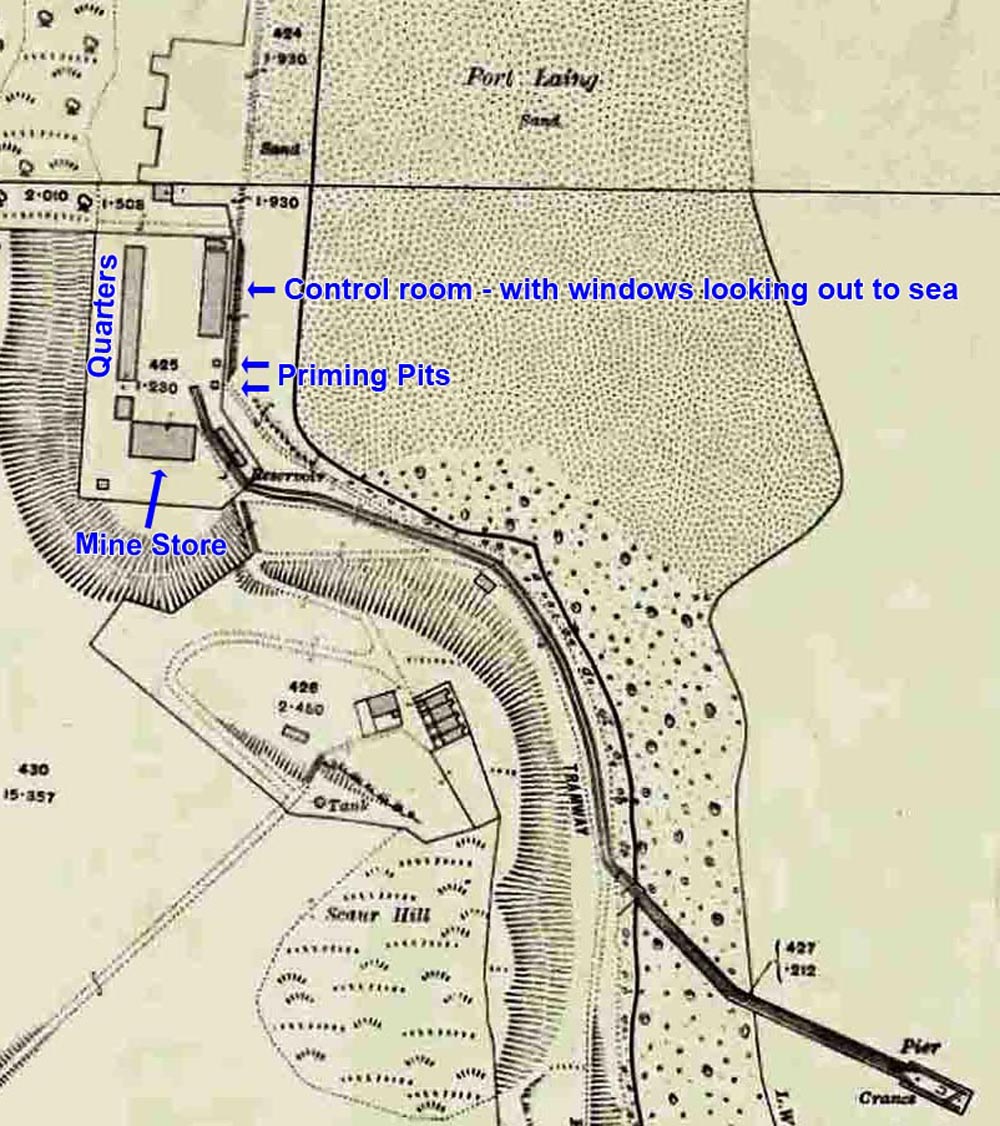
Given the appearance of the buildings, and the layout of the site it is likely that these were the functions of the various buildings
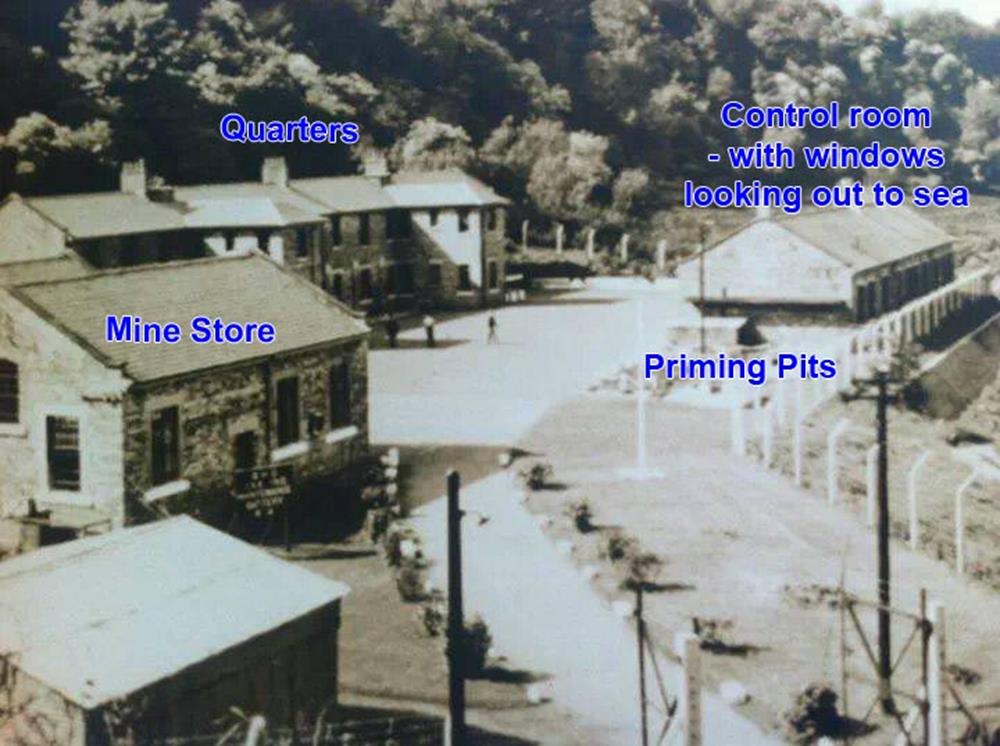
The priming pits are in the corner of the site. The tramway ran where the road is in this later photo.
As soon as an apparatus was primed, it was inserted in the mine by the mine store party. They worked in the loaded mine store which was about 40’ by 20’, and was fitted with an overhead traveller to lift weights up to one ton. An 18” tramline connected to the general system ran down the centre of the building. When the apparatus was inserted, the mines were lifted and placed one or two on a small truck, with their mooring lines and tripping wires if stored in the mine store. They remained on the truck till lifted off at the pier-head. To facilitate working in the mine store, the mines were stored in the order in which they were required by the laying-out party, and this order was known to the NCO in charge of the party.
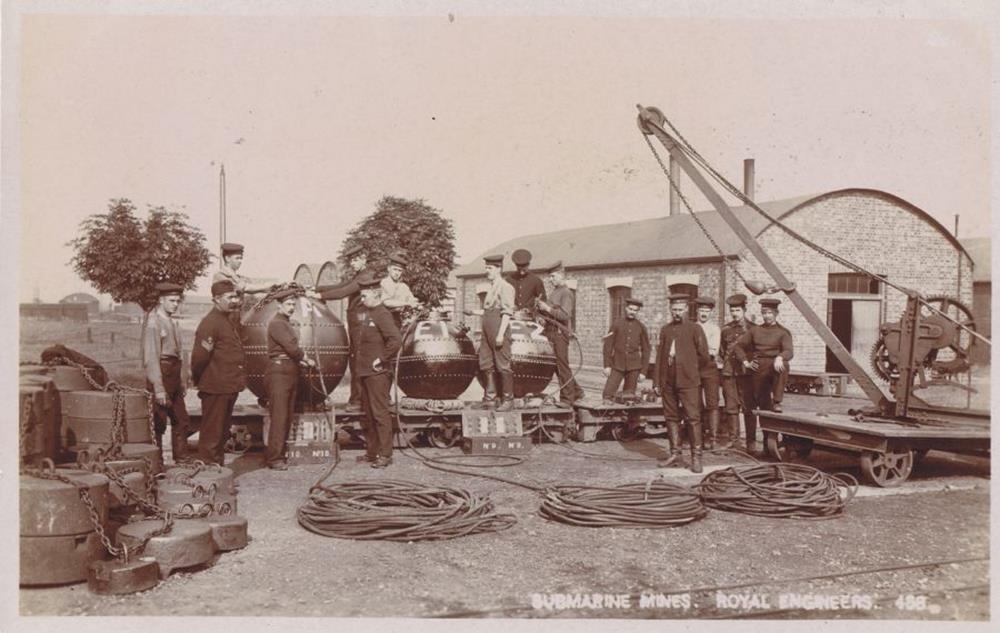
The fetching-stores party had meanwhile been cutting up and crowning cables and laying them out on the connecting-up ground. They also removed the loaded trucks from the mine store and brought in empty trucks.
The connecting-up parties had to first make the joints between the leads of the apparatus and the cable, then connect the mooring cables and stopper cables and mooring together, also fasten the ends of the tripping chain to the cable. Two to four such parties were usually detailed for this purpose. They left all the gear stowed on the truck, so that the mine could be lifted as a whole and put on the deck of a vessel.
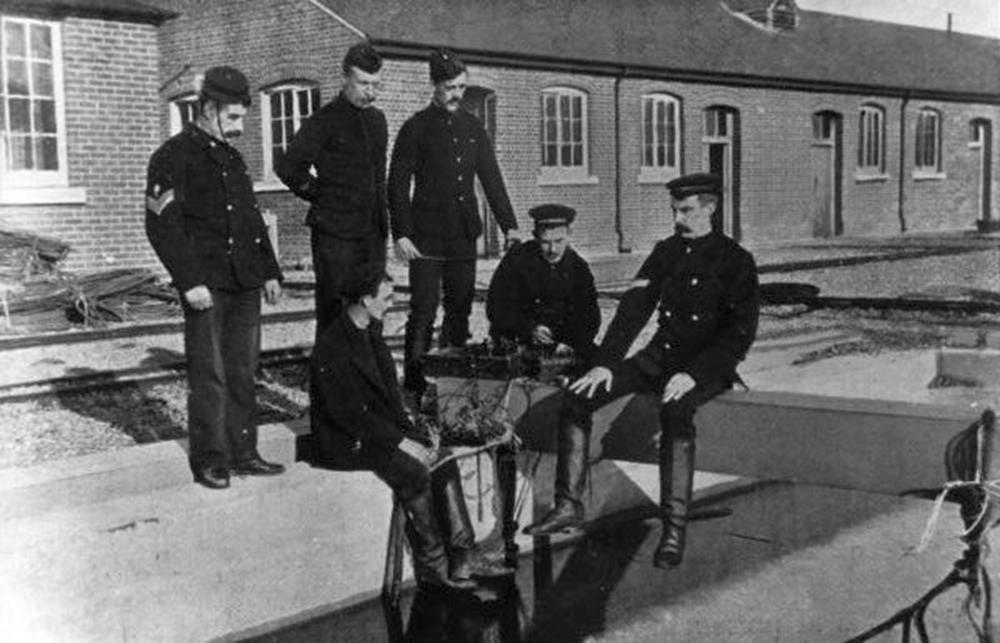
Making up cables and junction boxes – Gosport 1897
The pierhead parties took the mines from the connecting-up ground to the pierhead, lifting them off with the pierhead cranes onto the vessels deck, and sending empty trucks back to the mine store. One party was required for each crane in use, there were generally two on a pier.

Water-based parties
The laying-out parties worked on the vessel’s deck assisted by the crew. There were usually two parties, one on each side of the vessel, and their duties were to receive the mines on deck, sling them out in succession, and lay them out. Loading of the vessel was usually done from the stern, the forward mines being first laid out. E.C. mines [contact closer] were slung on either bow, using the bow and foremost derricks to lift them. Lines of mines [observation mines] required more space than E.C. mines [they were larger, and deployed in pairs.] Slinging was effected by short manila ropes passed through a ring of the mine or sinker, with both ends made fast on board.
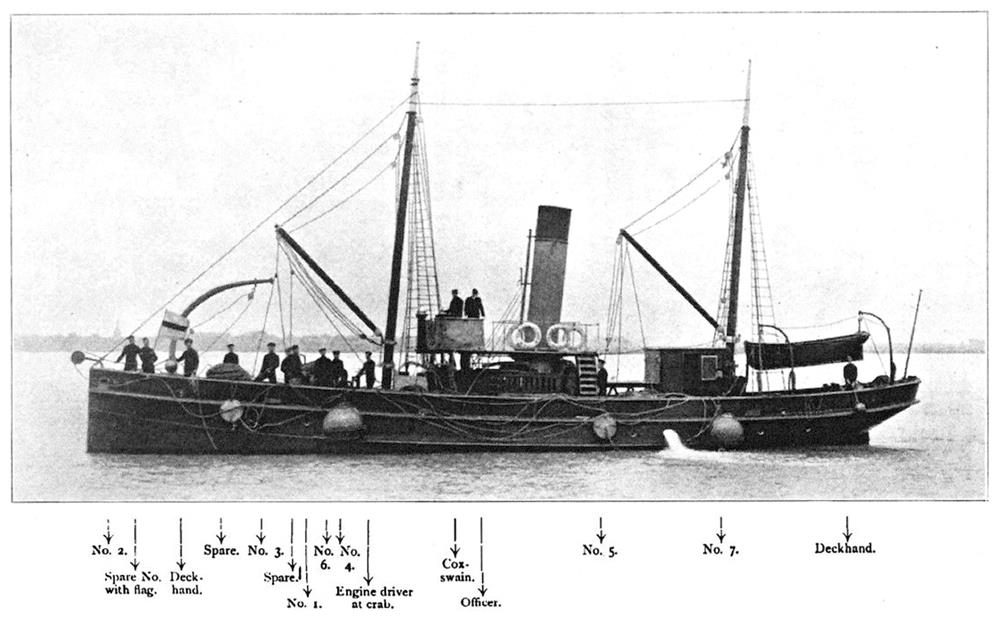
A mine-laying vessel, with a pair of mines, along with their connecting cables and sinker weights slung alongside before deployment.
The sinker or mine lay outside the vessel against the rubbing streak, and on reaching the position of the mine, one end of the short manila rope was let go and the weight slid down into the water. Sufficient cable was slung outboard to enable the weight to reach the bottom, and the remainder of the cable laid was laid out in a coil [to be managed by the junction-box party], latterly this coil was placed in a vertical wooden drum, designed by Capt. Organ of the Coast battalion, which facilitated paying out the cable.
A skilled crew was needed to get the boat into the right position relative to the planned position of the mine, the location of the adjacent junction boat, wind, tide, and the side of the vessel on which the mine was slung. The ideal was that when the mine was let go, the vessel would drop down gently next to but not touching the junction boat, pass over the cable from the mine, then go ahead to the location of the next mine.
The junction-box party consisted of two men capable of making joints, and one or two boatmen. They had to make the necessary joints, and any connections required when making tests, then lower the junction boxes without fouling any cables. The junction box linked the single-core cable from each pair of mines to four-core cable connected to the shore station. When the junction box was open on board the junction boat, a telephone connection was made to the shore station. Once the box was closed, orders were sent by signal flags.
Once everything was ready, the junction-box was lowered overboard, and final tests completed from the shore station, before the junction-box boat could leave its moorings and proceed to the next set of connections.
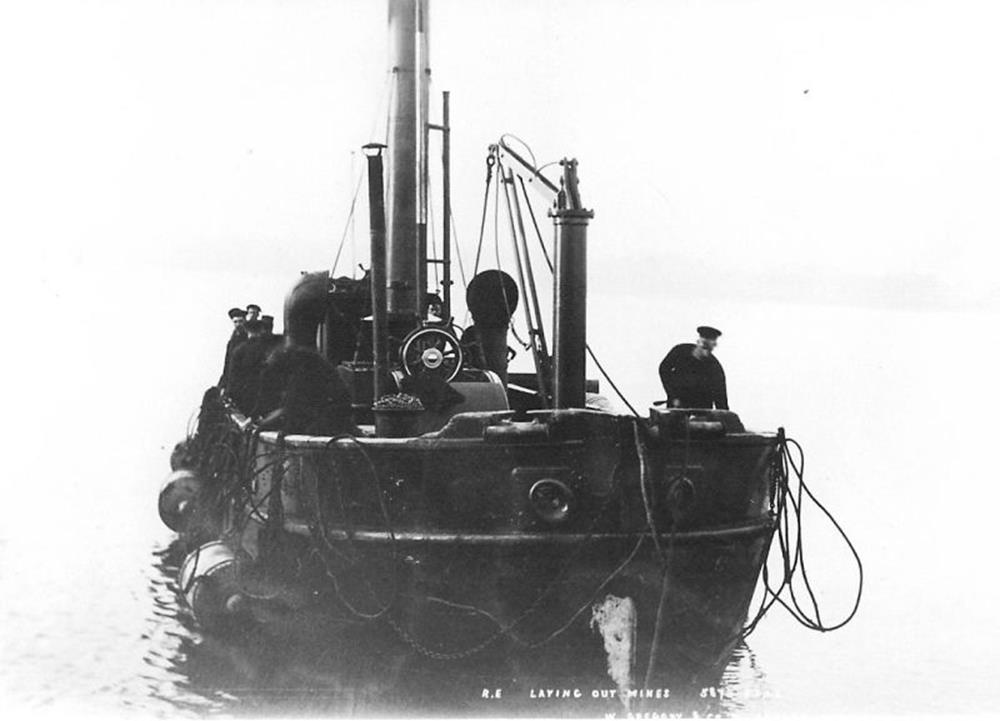
Laying mines in the Solent – 1897
Test room party
There were usually two or three men in the test room, and two men on each position finder, with a signalling party of two men at some prominent point, with a telephone connection to the test-room.

A Test Room – 1880
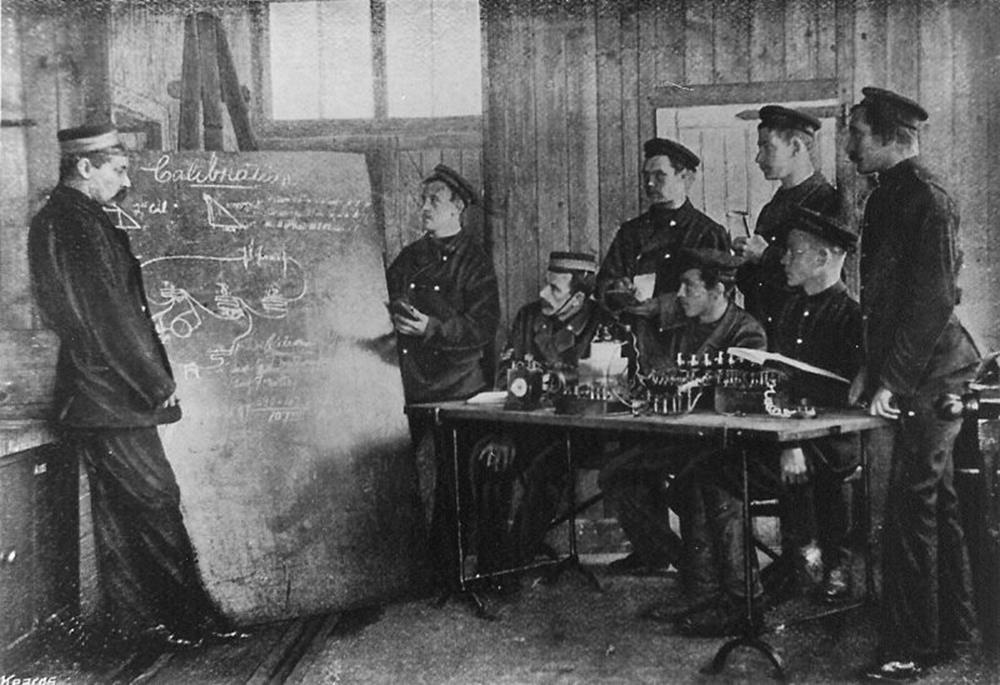
Instruction in the Test Room – 1897
With two laying-out vessels, twenty mines could be laid out in an hour, and as three or four tests were required for each mine, the tester had a busy time.
The alignment parties were usually required to hold up poles or flags in positions marked by pickets or sockets. They communicated with the vessels by flag signalling.
When mines had to be picked up, the order of operations was reversed, and the mines could be picked up very quickly. If any of the cables became fouled, either by mistake, or the action of tides, or if a cable broke, it took a great deal of skill and experience to unravel the knots. An axe was provided as a last resort, but it was considered bad form to have to use it!
Time to deploy a minefield
The average work rate for each operation was as follows:
Priming – four to six apparatus an hour for each pit
Connecting up – one party could connect up a group of EC mines in 20 to 25 minutes.
Embarking – with suitable cranes, four to six groups of EC mines in 20 to 35 minutes.
Laying – about eight EC mines an hour, sometimes ten or twelve, depending on the skill of the coxswain manoeuvring the boat.
Raising mines – four to six EC mines an hour.
With experienced teams, it was possible for two laying boats and associated parties to deploy a minefield of 100 mines in a 10 hour working day from 7.45 am to 5.45 pm. This performance was considered to be typical.
So the 140 to 180 mines needed to span the Forth could have been deployed comfortably in two working days. But only because of constant training and practice by these dedicate teams of volunteers.
| < The Port Laing Minefield | Δ Index | Port Laing Beach today > |
top of page
